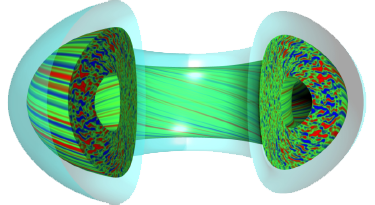Speaker
Description
WEST (tungsten –W– Experimental Steady-state Tokamak) is a device specialized for long pulse operation in a tungsten environment. Its main purpose is to study the plasma-wall interactions in a metallic environment and to be a test bed for ITER plasma facing components [1-3]. Between 40 and 50 diagnostics help to characterize WEST plasmas. The acquisition systems produce a large heterogeneous amount of data and we made a significant effort to unify data storage and to improve data access and traceability. To this end, we are using IMAS (Integrated Modelling and Analysis Suite) infrastructure to manage WEST experimental data [4]. The data processing workflow or plasma reconstruction chain allows for the integration of information coming from several diagnostics and the production of relevant data for scientific and operational purposes.
From the IMAS data processing workflow, we build a reduced database suited for validation, statistical analysis and machine learning algorithms. Three WEST experimental campaigns are included with a total of 2000 plasma pulses. This database is composed of two parts: the first one contains statistical moments describing quasi-steady states reached by the plasma (6000 quasi-steady states for more than 700 quantities); the second contains the same number of quantities but evolving in time (for example quantities as: averaged temperatures, densities, equilibrium parameters, etc.). The quasi-steady states are detected automatically, avoiding any bias that can appear when a human selection is made. The definition of a quasi-steady state is explicitly given to the detection algorithm by the user. The same definition is applied to all time signals and the algorithm extracts the quasi-steady states under the same assumptions. For example in WEST, a quasi-steady state is defined as a time interval of a minimum length of 0.3 seconds where both, plasma current and total power vary less than 5% (we call them quasi-steady because only these two signals are imposed to be slowly varying). On the other hand, the second part of the reduced database includes the time evolution. To illustrate the benefits of using this reduced two-fold database we present two analysis performed recently. The first one is the L-mode confinement time analysis in WEST and the comparison with an international tokamak database [5]. The second is the identification of two plasma confinement regimes: a good confinement regime characterized by a central electron temperature above 2.5 keV and a degraded confinement regime with electron temperatures below 2 keV (identification done using the first part of the reduced database). Thanks to the second part of the reduced database we are able to identify the main parameters driving this bifurcation (the precursors to the plasma regime separation). The main parameters found are: the lower hybrid (LH) power to plasma density ratio, the LH antenna reflection coefficient and the radial outer gap (equatorial distance between the LH antennas and the plasma separatrix). This identification done, we are able to make recommendations to WEST operational team on how to avoid the degraded confinement regime.
To summarize, from data processing using ITER relevant IMAS infrastructure we obtain a reduced database, in our case stationary states together with temporal data. The data structured as such allows to tackle different questions efficiently contributing to improve tokamak scientific analysis and operations.
[1] J. Bucalossi et al. 2021, Nucl. Fusion in press https://doi.org/10.1088/1741-4326/ac2525
[2] J. Bucalossi et al. 2014, Fusion Eng. Des. 89 907912
[3] C. Bourdelle et al. 2015, Nucl. Fusion 55 063017
[4] F. Imbeaux et al. 2015, Nucl. Fusion 55 123006
[5] V. Ostuni et al. 24th Transport and Confinement Topical Group Meeting IPP Garching, June 29 - July 3, 2020
| Country or International Organisation | France |
|---|---|
| Affiliation | CEA |

